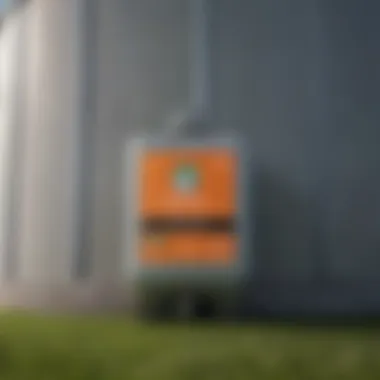The Comprehensive Guide to Bulk Liquid Lawn Fertilizer


Intro
Bulk liquid lawn fertilizer plays a crucial role in modern agriculture. The method of applying fertilizers in liquid form has gained traction among farmers and enthusiasts alike. This approach offers a range of benefits over traditional fertilizer options. It allows for more precise application, improves nutrient uptake by plants, and often reduces the risk of environmental contamination.
Understanding bulk liquid fertilizers involves several key concepts, including their formulations, application techniques, and the associated benefits and challenges. This guide aims to provide a comprehensive overview of these elements while addressing cost considerations and effective use practices.
The following sections will navigate through the essential terminology and concepts, explore recent innovations, and present practical applications and techniques for using bulk liquid fertilizers effectively.
Foreword to Bulk Liquid Lawn Fertilizer
Bulk liquid lawn fertilizer represents a significant advancement in modern agricultural practices. It plays a crucial role in promoting healthy lawns and crops by ensuring efficient nutrient delivery. The rise in popularity of bulk liquid fertilizers can be attributed to their ease of application and their effectiveness in meeting the nutritional requirements of plants.
Definition and Composition
Bulk liquid lawn fertilizer is a solution made from a blend of macro and micronutrients essential for plant growth. These solutions typically contain nitrogen, phosphorus, and potassium, which are the key nutrients required for healthy plant development. Additionally, many formulations may include trace elements such as iron, manganese, and zinc, providing a comprehensive nutrient profile. The liquid form allows for immediate absorption by plants, making it an attractive option for farmers and enthusiasts seeking quick results. The composition varies by brand and purpose, but the goal remains consistent: to nourish the soil and enhance plant health.
Historical Development
The concept of liquid fertilizers is not new, but the evolution of bulk liquid options has transformed their use in gardens and agricultural settings. Traditionally, fertilizers were used in granular forms, which presented challenges in application and absorption rates. Over the decades, technological advancements have led to the development of liquid fertilizers that can be produced in larger quantities, ensuring availability and affordability. This progress reflects a shift in agricultural practice, emphasizing efficiency and sustainability. Today, farmers and homeowners alike benefit from an array of formulations tailored to specific soil conditions and plant needs, resulting in enhanced growth and vitality.
Formulations of Bulk Liquid Fertilizers
Understanding the formulations of bulk liquid fertilizers is crucial for their effective application in both lawns and agricultural practices. These formulations determine the nutrient content, solubility, and overall effectiveness of the fertilizer. Variations in composition can lead to differences in how well plants absorb the nutrients they need for healthy growth.
The primary focus in bulk liquid fertilizers is to provide a balanced supply of essential nutrients. This is crucial due to the diverse needs of different plants at various growth stages. Formulating liquid fertilizers properly is essential for sustaining soil health and enhancing crop yields.
Key Nutrients in Liquid Fertilizers
Key nutrients in liquid fertilizers include nitrogen, phosphorus, and potassium, often referred to as N-P-K.
- Nitrogen plays an important role in promoting leafy growth. It is responsible for chlorophyll production, which is critical for photosynthesis.
- Phosphorus is necessary for root development and flowering. It helps plants to establish strong roots and enhances overall blooming.
- Potassium is vital for overall plant health and helps in water regulation, stress tolerance, and disease resistance.
These nutrients can be provided in different ratios, depending on the specific requirements of the plants being treated. Customizing the nutrient ratio can maximize the effectiveness of the fertilizer, allowing for targeted plant care.
Microbial Enhancements
Microbial enhancements in bulk liquid fertilizers are increasingly gaining recognition. These enhancements consist of beneficial microorganisms that can improve soil health and increase nutrient availability to plants.
- Mycorrhizal fungi establish a symbiotic relationship with plant roots, enhancing nutrient uptake, especially phosphorus.
- Bacteria like rhizobia and azospirilla can fix atmospheric nitrogen, making it available to plants. This minimizes the need for synthetic nitrogen fertilizers.
This addition of microbes can improve soil structure and promote nutrient cycling, further providing health benefits to the plants. In this way, microbial enhancements support environmental sustainability and contribute significantly to healthier lawns and crops.
"The proper formulation of liquid fertilizers, combined with microbial enhancements, can significantly elevate the overall quality and sustainability of agricultural practices."
Application Techniques
Application techniques are crucial to the effective use of bulk liquid lawn fertilizers. Understanding how to accurately apply these fertilizers can greatly influence their performance and benefits. Proper application can enhance nutrient absorption and minimize any potential negative impacts on the environment. Different methods and equipment come into play when applying these fertilizers, each offering distinct advantages and considerations.
Methods of Application
There are several methods for applying bulk liquid lawn fertilizers. It is essential to choose the right one based on the specific needs of the lawn or crop and the environmental conditions.
- Spraying: This is one of the most common methods. Liquid fertilizers can be sprayed using hand-held sprayers or tractor-mounted spray equipment. This method allows for even distribution and is effective for both small and large areas. However, special care should be taken to avoid drift, especially on windy days.
- Injecting: Injecting fertilizers directly into the soil is another method. This technique delivers nutrients directly to the plant roots. It is often used for larger landscapes or agricultural fields where precision is crucial.
- Flooding: This method involves applying the liquid fertilizer through irrigation systems. Flooding can help ensure that the nutrients reach the plant roots effectively, especially in sandy soils. This method also reduces labor but requires proper irrigation management.


"Choosing the right application method depends on various factors, including the type of crops, soil conditions, and weather."
When selecting a method of application, consider the specific requirements of the plants being fertilized, as well as the timing for optimal nutrient uptake.
Equipment Needed for Application
Selecting proper equipment for applying bulk liquid fertilizers can affect the efficiency and outcomes of the fertilization process. Below are some common types of equipment necessary for various application methods:
- Sprayers: Handheld sprayers are ideal for small areas. For larger plots, consider tractor-mounted or tow-behind sprayers. These sprayers allow for adjustable spray patterns, which can help control application rates and coverage.
- Injectors: Fertilizer injectors are designed for direct soil applications. They can be attached to most tractor or mower systems, allowing for precise application.
- Irrigation Systems: Sprinklers or drip irrigation systems can be adapted to facilitate liquid fertilizer application. This setup can optimize nutrient uptake while also aiding in water management.
- Calibration Tools: Proper calibration tools are vital. They ensure that the right amount of liquid fertilizer is applied consistently. Regular checking of the equipment is crucial to maintain accuracy.
Understanding the methods and equipment can significantly impact the results from using bulk liquid lawn fertilizers. The right techniques can lead to enhanced plant health and improved soil conditions.
Benefits of Bulk Liquid Lawn Fertilizer
The advantages of using bulk liquid lawn fertilizer are extensive and noteworthy. These benefits have implications for both agricultural practices and the ecological environment. Understanding these aspects is crucial for farmers and lawn enthusiasts who aim to achieve optimal growth in their lawns or crops. Liquid fertilizers stand out in their ability to deliver nutrients swiftly and efficiently while offering enhancements to soil health that can be observed over time.
Efficient Nutrient Delivery
Bulk liquid lawn fertilizers excel in nutrient delivery, which is one of their key advantages. When applied, these fertilizers can penetrate the soil more effectively than traditional granular options. The liquid form allows for rapid absorption by roots, ensuring that plants receive essential nutrients without delay. This is particularly important during critical growth phases when nutrient demand is high.
Moreover, the use of bulk liquid fertilizers can significantly reduce nutrient runoff. Since the product is administered with precision, there is less chance of over-application, which is often observed with solid fertilizers. Thus, it not only conserves resources but also mitigates environmental harm by lowering the chances of nutrient leaching into waterways.
"The efficiency of liquid fertilizers in delivering nutrients cannot be overstated; they provide an immediacy that solid forms often lack."
In addition to this, the use of bulk liquid fertilizers often requires less product to achieve the same results compared to traditional fertilizers. This efficiency translates into cost savings over time, making it a prudent choice for farmers and homeowners alike.
Improvement in Soil Health
Another significant benefit of bulk liquid lawn fertilizers is their positive impact on soil health. These fertilizers often contain not only macro and micro-nutrients but also beneficial microbes. These microbes play an essential role in promoting soil structure, enhancing nutrient cycling, and improving the availability of nutrients within the soil. This biological activity can lead to resilience against pests and diseases, resulting in healthier plants overall.
Additionally, liquid fertilizers contribute to creating a more favorable soil environment. They can help maintain moisture levels in the soil, which is beneficial during dry spells. By improving the soil’s moisture retention capabilities, liquid fertilizers ensure sustained nutrient uptake by plants.
Finally, studies have shown that regular use of liquid fertilizers often results in increased organic matter within the soil. This organic matter can boost soil fertility and lead to improved microbial diversity. These changes foster an ecosystem that supports not only the plants but also various beneficial organisms present in the soil.
Environmental Considerations
Environmental considerations are crucial when discussing bulk liquid lawn fertilizers. Their impact on ecosystems, water quality, and soil health must be thoroughly evaluated. As more farms seek efficient methods to enhance crop yields, understanding these implications will help in making informed decisions.
Impact on Soil and Water Quality
The use of bulk liquid fertilizers can significantly affect both soil and water quality. When applied appropriately, these fertilizers provide essential nutrients to plants, promoting healthy growth. However, mismanagement can lead to adverse environmental effects.
Excessive application may result in nutrient runoff into nearby water bodies. This can cause algal blooms, which deplete oxygen in the water and harm aquatic life. Research indicates that nitrogen and phosphorus are the primary culprits in water contamination. It is essential for users to employ careful application techniques to minimize such risks.
The quality of soil can also be improved through the correct use of liquid fertilizers. Microbial health and soil structure benefit from nutrient-rich inputs. Maintaining a balanced soil nutrient profile ensures that organic matter decomposes effectively, which in turn supports crop resilience.
Sustainable Practices in Fertilization
As agriculture evolves, sustainable practices are becoming increasingly necessary. Integrating bulk liquid fertilizers into sustainable practices goes beyond just application. It encompasses a holistic approach to lawn care and crop production.
- Soil Testing: Regular soil testing helps determine nutrient levels and needs, preventing over-application. This promotes both environment-friendly practices and effective crop growth.
- Precision Agriculture: Utilizing technologies such as GPS and sensors allows farmers to apply fertilizers more accurately. This reduces waste and enhances the effectiveness of theapplication.
- Composting: Combining bulk liquid fertilizers with organic compost can improve soil fertility while reducing the environmental footprint. This process enriches the soil and helps maintain its structure.
- Nutrient Cycling: Practices such as crop rotation and cover cropping enhance nutrient cycles. These methods support the natural balance of ecosystems and help reduce reliance on chemical inputs.
By embracing these sustainable practices, farmers can not only optimize their yields but also contribute positively to their surrounding environment. \n \n> "Sustainable practices in fertilization not only ensure healthier crops but also safeguard our natural resources for future generations."


In summary, considering environmental implications is vital when using bulk liquid lawn fertilizers. Assessing impact on soil and water quality, and implementing sustainable practices, can lead to a more responsible and efficient agricultural sector.
Cost Analysis
Cost analysis is a critical component when assessing the overall value of bulk liquid lawn fertilizers. This section aims to illuminate various aspects of cost associated with both the adoption of these fertilizers and their subsequent application on agricultural landscapes. It weighs the financial implications against the potential benefits, such as health improvements for both lawns and crops, which makes it particularly relevant for farmers and landscaping professionals.
Understanding the costs involved also helps farmers make informed decisions, optimizing their inputs for profitability. From purchasing prices to application methods, cost efficiency can have lasting effects on overall yield and success.
Pricing Models of Bulk Liquid Fertilizers
Pricing of bulk liquid fertilizers is influenced by several factors, including formulation, supplier pricing strategies, and regional market dynamics. Common pricing models for bulk fertilizers reflect both the composition and expected efficacy. For instance, a high-nutrient liquid fertilizer often commands a premium price due to its enhanced effectiveness and formulation complexity.
- Volume-Based Pricing: This approach incentivizes larger purchases by reducing the price per unit as the volume increases. This model can be beneficial for larger agricultural operations.
- Contract Pricing: Some suppliers might offer contracts for consistent supply over time, impacting overall cost by locking in prices against market fluctuations.
- Custom Formulation Costs: If a specific nutrient profile is required, additional charges may apply for formulation tailored to specific soil or crop needs.
In general, while bulk liquid fertilizers might seem pricier initially, their efficient application and nutrient release can lead to better overall return on investment.
Comparison with Solid Fertilizers
When comparing bulk liquid fertilizers to their solid counterparts, several financial considerations come into play.
- Initial Investment: Solid fertilizers typically have lower upfront costs. However, bulk liquid fertilizers can lessen long-term expenses due to their application efficiency.
- Application Costs: The costs related to the application process can also differ significantly. Bulk liquid fertilizers allow for quicker and often more uniform application, which can reduce labor costs and time spent compared to solid fertilizers.
- Nutrient Stabilization: Liquid formulations can prevent nutrient loss through volatilization and leaching, a common issue with solids. This means farmers may find they need to apply less frequently, leading to savings.
In summary, while solid fertilizers may initially seem like a financially sound choice, the effective use of bulk liquid fertilizers can drive costs down in the long run, often yielding superior results.
Investing in bulk liquid fertilizers may incur higher initial costs, but the enhanced efficiency and yield can provide significant savings over time.
Comparison with Traditional Fertilizers
In the realm of lawn care and agricultural practices, the comparison between bulk liquid fertilizers and traditional solid fertilizers takes center stage. Understanding the distinctions is crucial for both efficiency and effectiveness in feeding plants. Each type offers unique advantages and can cater to different needs within the growing cycle. With rising concerns about environmental impacts and sustainability, it becomes even more critical to evaluate these options within the broader context of agricultural practices.
Nutrient Release Rates
When evaluating fertilizers, one of the essential factors is the nutrient release rate. Bulk liquid fertilizers typically provide nutrients in a more immediate form than their traditional counterparts. For example, liquid fertilizers can be rapidly absorbed by plants, which often results in quicker green-up and growth. This immediacy can be vital during critical growth stages.
In contrast, traditional fertilizers usually release nutrients at a slower pace. This slow-release characteristic can help maintain a steady supply of nutrients over an extended period, reducing the need for frequent applications.
Consider the specific needs of your lawn or crop when choosing between these two. In situations requiring immediate nutrient uptake, bulk liquid fertilizers may be more beneficial. However, for long-lingering nutrient availability, traditional fertilizers might suffice. It's vital to align the choice with growth timelines and environmental conditions.
User Experience and Efficiency
User experience with fertilizers plays a significant role in their adoption. Bulk liquid fertilizers often gain favor due to their ease of application and reduced labor intensity. For large-scale operations, the application of liquid fertilizers can facilitate a more efficient process. Liquid can be sprayed over large areas in less time compared to the manual spreading of granular fertilizers.
However, the convenience of liquid fertilizers should be balanced with careful handling and storage considerations. While they fluidly integrate with irrigation systems, improper mixing or application can lead to uneven distribution. Traditional solid fertilizers, on the other hand, offer a level of familiarity. Many users appreciate the straightforward nature of applying granules, which do not require specialized equipment.
To summarize, choosing between bulk liquid fertilizers and traditional solid fertilizers must account for several factors:
- Nutrient Release Rates: Liquid fertilizers can deliver quick nutrients, while traditional forms offer longevity.
- User Experience: Liquid fertilizers are often more efficient for large-scale applications, but require careful handling.
The best choice often depends on specific agricultural goals and conditions. It is advisable to analyze the unique needs of your operation while remaining cognizant of both immediate and long-term crop requirements.
"Understanding the right type of fertilizer can have a profound effect on growth efficiency and overall sustainability in agriculture."
This nuanced comparison underscores why selecting the appropriate fertilizer is a cornerstone decision for farmers and lawn care professionals alike.


Best Practices for Using Bulk Liquid Fertilizer
Using bulk liquid fertilizer effectively requires understanding key principles. This section addresses the best practices for application, ensuring optimal results for lawns and crops. Proper use not only enhances plant growth but also promotes environmental sustainability. Here are some considerations:
Timing and Frequency of Application
Determining the right time and frequency for applying bulk liquid fertilizer is crucial. Each type of grass or crop has its own growth cycle. Therefore, understanding these cycles can lead to more targeted nutrient delivery.
- Seasonal Timing: Application should align with the growing season for optimal absorption. For cool-season grasses, early spring and fall are ideal, whereas warm-season grasses benefit from timing in late spring.
- Weather Conditions: Avoid applying fertilizer before heavy rain. This reduces the risk of runoff. Ideally, choose a day when rainfall is unlikely.
- Soil Temperature: Monitor soil temperature; nutrient uptake is highest when temperatures reach optimal levels for growth.
- Frequency: Frequent, light applications often yield better results than a heavy dose. This allows for consistent nutrition without overwhelming plants.
"Regular, strategic applications of fertilizer can enhance nutrient uptake and help plants thrive."
Compatibility with Other Inputs
Bulk liquid fertilizers can be used alongside other inputs, but it's important to check compatibility. Proper integration can maximize nutrient efficiency. Consider these factors:
- Pesticides and Herbicides: Some chemicals may react negatively with liquid fertilizers. Always read product labels for compatibility information.
- Soil Amendments: Liquid fertilizers can be combined with soil conditioners like lime or gypsum. This can improve soil structure and health, but check for interactions that influence performance.
- Watering Regimens: Fertilizers are most effective when applied with a plan for irrigation. Ensure that water isn't excess or too little, maintaining a balance.
- Application Tools: Understand if your spreaders or tanks are suitable for the liquid's viscosity. Transmission issues can occur if equipment is not compatible.
Challenges and Considerations
The use of bulk liquid lawn fertilizer is not without challenges. Understanding these challenges is essential for agricultural farmers and enthusiasts to navigate the complexities of effective lawn care. This section discusses important aspects concerning storage and handling issues, as well as the significance of regulatory compliance. Both elements play a critical role in the successful application and overall effectiveness of liquid fertilizers.
Storage and Handling Issues
Effective management of storage and handling can considerably affect the quality of bulk liquid fertilizers. These products are sensitive to environmental factors. For instance, extreme temperatures can cause degradation of nutrients within the fertilizer. Therefore, it is crucial to store liquid fertilizers in a controlled environment.
- Temperature control: Ideal storage temperatures usually range between 50°F and 70°F. Exceeding this range can lead to nutrient instability.
- Container integrity: The selection of appropriate containers is vital. Using materials that resist chemical reactions ensures the fertilizer maintains its efficacy.
- Spillage prevention: Proper handling techniques minimize the risk of spills and leaks, which can waste fertilizer and potentially harm local ecosystems.
Adopting robust inventory management systems can further reduce mishaps associated with storage and handling. Regular inspections and training on proper handling techniques are equally beneficial in assuring both quality and safety during application.
Regulatory Compliance
Compliance with regulations is a fundamental aspect of using bulk liquid fertilizers. Various laws govern the application, storage, and transport of these substances, and understanding them helps reduce legal liabilities.
- Labeling requirements: Fertilizers must have accurate labels that comply with local and federal guidelines. This includes details about nutrient content, application rates, and safety instructions.
- Environmental regulations: Farmers should be aware of regulations aimed at minimizing environmental impact. For instance, certain areas may have restrictions on the timing of fertilizer applications to protect water quality.
- Record keeping: Maintaining records of fertilizer applications not only supports compliance but also assists in assessing effectiveness over time.
Adhering to these regulations nicht only promotes sustainable practices but also builds trust with consumers and the community. Furthermore, regulatory compliance can lead to better market access and financial opportunities.
Compliance with regulations is essential not only for sustainability but for the reputation of the agricultural industry as a whole.
Future Trends in Lawn Fertilization
The landscape of lawn fertilization is shifting rapidly, influenced by advancements in technology and changing consumer behavior. Understanding these future trends is crucial not only for optimizing lawn health but also for adapting to the broader agricultural framework. These trends reflect both innovations in product formulations and an evolving consciousness among users about sustainable practices and efficiency.
Emerging Technologies
Emerging technologies play a pivotal role in the future of lawn fertilization. Innovations such as precision agriculture tools are becoming more prevalent. These tools assist in the monitoring and application of nutrients with great precision. For example, sensors can assess soil nutrient levels in real time, allowing for more tailored fertilization strategies that meet the specific needs of the lawn. Drones are also increasingly used to apply fertilizers over large areas, ensuring uniform coverage and reduced labor costs.
Additionally, the integration of artificial intelligence in agricultural practices enables farmers and lawn care professionals to analyze vast data sets. This analysis helps in predicting fertilizer needs based on historical weather patterns and soil conditions. Farmers using these technologies can significantly reduce waste and improve efficiency, ultimately enhancing crop yield whilst also protecting the environment.
The rise of biotechnological advances, like slow-release and stabilized fertilizers, is another key trend. These products allow nutrients to be released over a longer period, minimizing runoff and enhancing nutrient uptake by plants. This becomes increasingly important in environmentally conscious markets.
Shifts in Consumer Preferences
Shifts in consumer preferences are redefining the fertilizer market. Modern consumers are more informed and place greater emphasis on sustainability. There is a growing demand for organic and environmentally friendly lawn care products. Bulk liquid fertilizers are seeing an upsurge in popularity because they often come in formulations that support organic gardening practices. This is crucial for consumers who wish to minimize their ecological footprint while maintaining a healthy lawn.
Furthermore, consumers are becoming increasingly interested in the efficiency and effectiveness of products. They often look for fertilizers that offer quick results without compromising long-term soil health. As a result, manufacturers are compelled to create products that deliver immediate improvements while fostering sustainable soil ecosystems. The awareness about nutrient pollution has led consumers to seek out products that minimize leaching and runoff.
"The future of lawn care is encapsulated in the application of technology and the harnessing of consumer preferences for sustainability and efficiency."
In summary, future trends in lawn fertilization are shaped by technological advancements and shifting consumer values. Staying abreast of these trends is essential for anyone involved in lawn care or agricultural practices. Not only do they provide insight into effective fertilization techniques, but they also highlight the importance of aligning with modern environmental and consumer standards.















